We have jargon, we have words, we have phrases…we have terms. Can words become terms? How would that happen? And has “the cloud” arrived as a technical concept yet?
 Cloud, as a word, is part of our everyday vocabulary. With the summer over, it’ll again be part of our daily lives in the Pacific Northwest for the next eight months. On the right is a good definition from the Merriam Webster Learner’s Dictionary. The Learner’s Dictionary is not concerned with technical language, as it is compiled for non-native speakers. So, the definition doesn’t allude to the fact that clouds, in a related sense, are also part of the field of meteorology and therefore part of a language for special purposes (LSP).
Cloud, as a word, is part of our everyday vocabulary. With the summer over, it’ll again be part of our daily lives in the Pacific Northwest for the next eight months. On the right is a good definition from the Merriam Webster Learner’s Dictionary. The Learner’s Dictionary is not concerned with technical language, as it is compiled for non-native speakers. So, the definition doesn’t allude to the fact that clouds, in a related sense, are also part of the field of meteorology and therefore part of a language for special purposes (LSP).
When common everyday words are used in technical communication and with specialized meaning, they have become terms through a process called terminologization. Is cloud, as in cloud computing, there yet? Or is it still in this murky area where marketing babel meets technical communication? It certainly was initially.
Here is a great blog on when cloud was used for the first time. Author John M. Willis asked his Twitter followers Who Coined The Phrase Cloud Computing? and could then trace back the first occurrences to May of 1997 and a patent application for “cloud computing” by NetCentric; then to a 1999 NYT article that referred to a Microsoft “cloud of computers”, and finally to a speech by Google’s Eric Schmidt who Willis says he would pick as the moment when the cloud metaphor became mainstream.
 That was 2006, and “the cloud” may have become part of the tech world’s hype, but it wasn’t a technical term with a solid and clearly delineated definition. As Willis points out “cloud computing was a collection of related concepts that people recognized, but didn’t really have a good descriptor for, a definition in search of a term, you could say.”
That was 2006, and “the cloud” may have become part of the tech world’s hype, but it wasn’t a technical term with a solid and clearly delineated definition. As Willis points out “cloud computing was a collection of related concepts that people recognized, but didn’t really have a good descriptor for, a definition in search of a term, you could say.”
Yes, we had the designator, but did we really have a clear definition? In my mind, everyone defined it differently. For a while, the idea of “the cloud” was batted around mostly by marketing and advertising folks whose job it is to use hip language and create positive connotations. When “the cloud” and other marketing jargon sound like dreams coming true to disposed audiences, they usually spell nightmare to terminologists. The path of a “cloud dream” into technical language is a difficult one. In 2008, I was part of a terminology taskforce within the Windows Server team who tried to nail down what cloud computing was. I believe the final definition wasn’t set when I left in May 2010.
An Azure architect evangelist (See You say Aaaazure, I say Azuuuure…) and I recently analyzed the conceptual area. Although he kept saying that some of the many companies in cloud computing these days “would also include x, y, or z,” x, y and z all turned out to not be “essential characteristics.” And we ended up with the following definition. It is based largely on the one published by Netlingo, but modified to meet more of the criteria of a terminological definition:
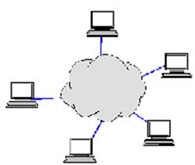 “A type of computing in which dynamic, scalable and virtual resources are provided over the Internet and which includes services that provide common business applications online and accessible from a Web browser, while the software and data are stored on servers.”
“A type of computing in which dynamic, scalable and virtual resources are provided over the Internet and which includes services that provide common business applications online and accessible from a Web browser, while the software and data are stored on servers.”
Wouldn’t it be great, if a terminologist could stand by to assist any time a new concept is being created somewhere? Then, we’d have nice definitions and well-formed terms and appellations right away. Since that is utopia, at least it helps to be aware that language is in flux, that marketing language might be deliberately nebulous, and that it might take time before a majority of experts have agreed on what something is and how it is different from other things around it. I think “the cloud” and “cloud computing” have been terminologized and arrived in technical language.
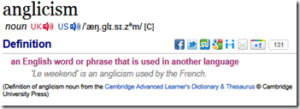
 I had worked in the US for many years prior to joining the team in Munich and more than once smiled inwardly, when people essentially butchered both languages. I think it a bit more disturbing, when journalists litter their reports with Anglicisms, even if some of the words may eventually become part of the German language. On May 25, the announcer on Bayern 5, a news station that I listen to over the internet, said that due to the eruption of the Grimsvötn volcano not all flights had left airports as planned. She said something to the extent of “Airlines haben Flüge gecancelt…und Maschinen konnten den Airport nicht verlassen.“ Needless to say, there are perfectly good German words for airlines, cancel and airport.
I had worked in the US for many years prior to joining the team in Munich and more than once smiled inwardly, when people essentially butchered both languages. I think it a bit more disturbing, when journalists litter their reports with Anglicisms, even if some of the words may eventually become part of the German language. On May 25, the announcer on Bayern 5, a news station that I listen to over the internet, said that due to the eruption of the Grimsvötn volcano not all flights had left airports as planned. She said something to the extent of “Airlines haben Flüge gecancelt…und Maschinen konnten den Airport nicht verlassen.“ Needless to say, there are perfectly good German words for airlines, cancel and airport.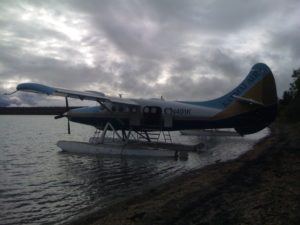
 This park, located in the southwestern corner of Alaska, was founded following a volcanic eruption in 1912. The explosion of Novarupta was the largest volcanic event of the 20 century, and ashes could be found as far away as Africa. When researchers around Robert Griggs ventured back into the area, they found what they thought were small sources of fire still smoldering and dubbed the place ‘Valley of Ten Thousand Smokes.’ Years later upon closer investigation, the “smoke” turned out to come from the Ukak River that had gotten buried underneath the lava. Instead of particles produced by combustion, water vapor was rising from the lava fields. The misnomer of the valley stuck, though, but outside of the proper noun, “smoke” has since been put in quotes on most boards and documents.
This park, located in the southwestern corner of Alaska, was founded following a volcanic eruption in 1912. The explosion of Novarupta was the largest volcanic event of the 20 century, and ashes could be found as far away as Africa. When researchers around Robert Griggs ventured back into the area, they found what they thought were small sources of fire still smoldering and dubbed the place ‘Valley of Ten Thousand Smokes.’ Years later upon closer investigation, the “smoke” turned out to come from the Ukak River that had gotten buried underneath the lava. Instead of particles produced by combustion, water vapor was rising from the lava fields. The misnomer of the valley stuck, though, but outside of the proper noun, “smoke” has since been put in quotes on most boards and documents.
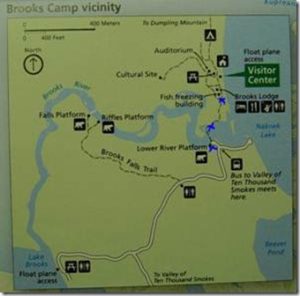
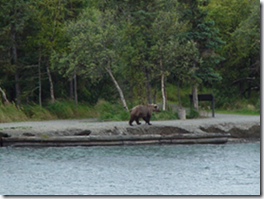 While names of most landmarks had emerged over the years, returning rangers drew up a map to define important places for newcomers. Naming was logical and communication was adjusted seamlessly to recipient (fellow ranger or guest) and method (radio or face-to-face). While this might seem an obvious behavior, it is one that clearly contributes to the safety of the environment. Besides these professional observations, my father and I had an incredible time at Katmai National Park.
While names of most landmarks had emerged over the years, returning rangers drew up a map to define important places for newcomers. Naming was logical and communication was adjusted seamlessly to recipient (fellow ranger or guest) and method (radio or face-to-face). While this might seem an obvious behavior, it is one that clearly contributes to the safety of the environment. Besides these professional observations, my father and I had an incredible time at Katmai National Park.